Aztec codices
The Aztec codices (Nahuatl languages: Mēxihcatl āmoxtli Nahuatl pronunciation: [meːˈʃiʔkatɬ aːˈmoʃtɬi]) are books written by pre-Columbian and colonial-era Nahuas in pictorial or alphabetic form.
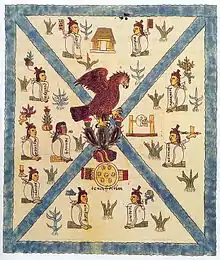
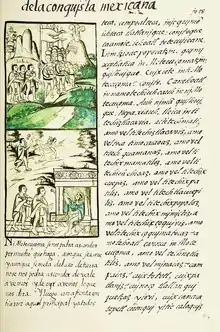
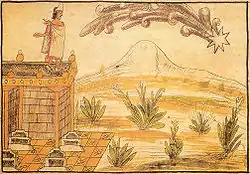
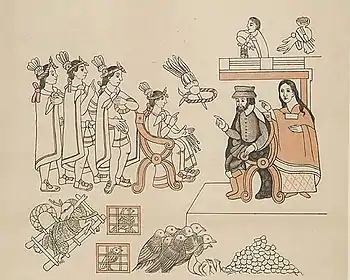
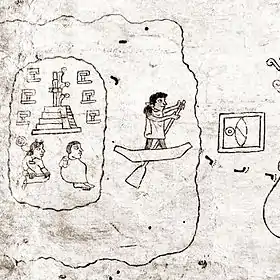
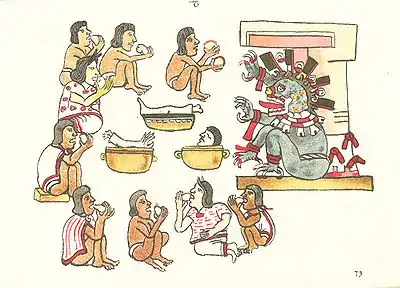
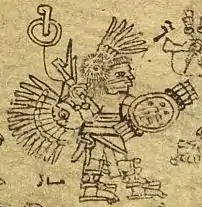
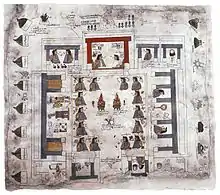
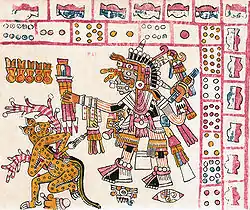
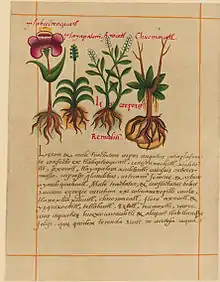
Style and Design
Before the Spanish Conquest, the Aztecs and their neighbors in and around the Valley of Mexico relied on painted books and records to document almost all aspects of their lives. Painted manuscripts contained information about their history, science, land tenure, tribute, and sacred rituals. After the Conquest, the Aztec continued to think and express themselves visually, and the Spaniards came to accept and rely on the painted manuscripts as valid and potentially important records. The native tradition of pictorial documentation and expression continued strongly in the Valley of Mexico several generations after the arrival of Europeans. The latest examples of this tradition reaching into the early seventeenth century.[1]
Aztec codices provide some of the best primary sources for Aztec culture. The pre-Columbian codices mostly do not in fact use the codex form (that of a modern paperback) and are, or originally were, long folded sheets. These sheets were typically made from stretched deerskin or from the fibers of the agave plant.[2] They also differ from European books in that they mostly consist of images and pictograms; they were not meant to symbolize spoken or written narratives. These pictograms were almost always brightly colored with the first layer being solid black and colors painted on top. Writing itself was very seldom used in books or documents. It was reserved to complement the kindred systems of notation and iconography by specifying the names of individuals, peoples, and places, and to a lesser extent ranks, titles and professions. Full sentences were rarely found in Aztec writing and were replaced by a series of pictures or symbols that could have different meanings depending on the context.
The types of information in manuscripts fall into several categories: calendrical, historical, genealogical, cartographic, economic/tribute, economic/census and cadastral, and economic/property plans.[3] A census of 434 pictorial manuscripts of all of Mesoamerica gives information on the title, synonyms, location, history, publication status, regional classification, date, physical description, description of the work itself, a bibliographical essay, list of copies, and a bibliography.[4] Indigenous texts known as Techialoyan manuscripts are written on native paper (amatl) are also surveyed. They follow a standard format, usually written in alphabetic Nahuatl with pictorial content concerning a meeting of a given indigenous pueblo's leadership and their marking out the boundaries of the municipality.[5] A type of colonial-era pictorial religious texts are catechisms called Testerian manuscripts. They contain prayers and mnemonic devices.[6] An interesting type of pictorial codex are ones deliberately falsified. John B. Glass published a catalog of such manuscripts that were published without the forgeries being known at the time.[7]
Another mixed alphabetic and pictorial source for Mesoamerican ethnohistory is the late sixteenth-century Relaciones geográficas, with information on individual indigenous settlements in colonial Mexico, created on the orders of the Spanish crown. Each relación was ideally to include a pictorial of the town, usually done by an indigenous resident connected with town government. Although these manuscripts were created for Spanish administrative purposes, they contain important information about the history and geography of indigenous polities.[8][9][10][11]
Important Codices
Particularly important colonial-era codices that are published with scholarly English translations are Codex Mendoza, the Florentine Codex, and the works by Diego Durán. Codex Mendoza is a mixed pictorial, alphabetic Spanish manuscript.[12] Of supreme importance is the Florentine Codex, a project directed by Franciscan friar Bernardino de Sahagún, who drew on indigenous informants' knowledge of Aztec religion, social structure, natural history, and includes a history of the Spanish conquest of the Aztec Empire from the Mexica viewpoint.[13] The project resulted in twelve books, bound into three volumes, of bilingual Nahuatl/Spanish alphabetic text, with illustrations by native artists; the Nahuatl has been translated into English.[14] Also important are the works of Dominican Diego Durán, who drew on indigenous pictorials and living informants to create illustrated texts on history and religion.[15] The colonial-era codices often contain Aztec pictograms or other pictorial elements. Some are written in alphabetic text in Classical Nahuatl (in the Latin alphabet) or Spanish, and occasionally Latin. Some are entirely in Nahuatl without pictorial content. Although there are very few surviving prehispanic codices, the tlacuilo (codex painter) tradition endured the transition to colonial culture; scholars now have access to a body of around 500 colonial-era codices.
Some prose manuscripts in the indigenous tradition sometimes have pictorial content, such as the Florentine Codex, Codex Mendoza, and the works of Durán, but others are entirely alphabetic in Spanish or Nahuatl. Charles Gibson has written an overview of such manuscripts, and with John B. Glass compiled a census. They list 130 manuscripts for Central Mexico.[16][17] A large section at the end has reproductions of pictorials, many from central Mexico.
Preservation
A large number of prehispanic and colonial indigenous texts have disappeared over time. For example, when Hernan Cortés and his six hundred conquistadores landed on the Aztec land in 1519, they found that the Aztecs had many beautifully bound books. The writing was complex and sophisticated, comparable to Egyptian hieroglyphs, and developed by the Mayans. These codices held the history of the great Aztec empire and included minute details of community life, important events, religion, and biographies. After Cortes conquered the Aztecs, the native codices were seen as a threat by the Spanish Catholic priests who wanted the people to accept Spanish rule and forget their own history. Most priests, with the exception of Bartolomé de las Casas, searched for and destroyed all the codices and other texts they could find. The irony lies in that these codices were in fact altered versions of actual Mayan codices that portrayed the Aztecs as rightful rulers. The original Mayan codices having been burned by the Aztecs after they dominated the Mayans before Cortés arrived. [18]
However, the large extant body of manuscripts that did survive can now be found in museums, archives, and private collections. There has been considerable scholarly work on individual codices as well as the daunting task of classification and description. A major publication project by scholars of Mesoamerican ethnohistory was brought to fruition in the 1970s, of which a large portion of the material is related to central Mexico. The four-volume Guide to Ethnohistorical Sources, Handbook of Middle American Indians has two volumes focusing on pictorial manuscripts, including a reproduction of many images of pictorials; one volume deals with publications of Mesoamerican documents found in collections and printed religious and secular accounts, and one entirely devoted to the Relaciones geográficas. In the two volumes on pictorials, a general survey outlines the origins of Mesoamerican manuscripts, classifies them, and situates them in a regional survey.
Colonial-era local-level Nahuatl language documentation is the foundational texts of the New Philology, which utilizes these texts to create scholarly works from the indigenous viewpoint. These are often are sometimes found as a single, documentary corpus, while such documentation can also be found scattered in legal documentation in individual lawsuits. There are a variety of documents, and include censuses such as The Book of Tributes (c. 1535); wills and testaments, such as The Testaments of Culhuacan and The Testaments of Toluca, town council records, such as The Tlaxcalan Actas. Colonial-era indigenous elites also kept documentation of their properties and privileges, as part of their cacicazgos.[19]
List of codices
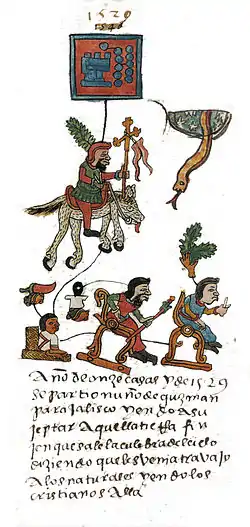
- Anales de Tlatelolco, an early colonial era set of annals written in Nahuatl, with no pictorial content. It contains information on Tlatelolco's participation in the Spanish conquest.
- Badianus Herbal Manuscript is formally called Libellus de Medicinalibus Indorum Herbis (Latin for "Little Book of the Medicinal Herbs of the Indians") is a herbal manuscript, describing the medicinal properties of various plants used by the Aztecs. It was translated into Latin by Juan Badiano, from a Nahuatl original composed in the Colegio de Santa Cruz de Tlatelolco in 1552 by Martín de la Cruz that is no longer extant. The Libellus is better known as the Badianus Manuscript, after the translator; the Codex de la Cruz-Badiano, after both the original author and translator; and the Codex Barberini, after Cardinal Francesco Barberini, who had possession of the manuscript in the early 17th century.[20]
- The Book of Tributes, a set of house-to-house censuses in alphabetic Nahuatl, with no pictorial content, from the Cuernavaca region, written ca. 1535. They are the earliest extant local-level Nahuatl documentation, probably done in response to the Spanish crown's dispute with Hernán Cortés who was granted the tributes from encomiendas in what is now Morelos. It is notable for the number of unbaptized members of households a decade after the beginning of the so-called "spiritual conquest" of Mexico.[21][22][23]
- The Borgia Group of manuscripts are distinguished by their religious content. They include Codex Borgia, after which the group is named; Codex Cospi; Codex Fejérváry-Mayer; Codex Laud; and Codex Vaticanus B. Also sometimes included are the Aubin Manuscript No. 20 (or Fonds mexicain 20) and the Codex Porfirio Diaz
- Cantares Mexicanos - a collection of Nahuatl songs transcribed in the mid-16th century.
- Chavero Codex of Huexotzingo
- Codex Azcatitlan, a pictorial history of the Aztec empire, including images of the conquest
- Codex Aubin is a pictorial history or annal of the Aztecs from their departure from Aztlán, through the Spanish conquest, to the early Spanish colonial period, ending in 1608. Consisting of 81 leaves, it is two independent manuscripts, now bound together. The opening pages of the first, an annals history, bear the date of 1576, leading to its informal title, Manuscrito de 1576 ("The Manuscript of 1576"), although its year entries run to 1608. Among other topics, Codex Aubin has a native description of the massacre at the temple in Tenochtitlan in 1520. The second part of this codex is a list of the native rulers of Tenochtitlan, up to 1607. It is held by the British Museum and a copy of its commentary is at the Bibliothèque Nationale de France. A copy of the original is held at the Princeton University library in the Robert Garrett Collection. The Aubin Codex is not to be confused with the similarly named Aubin Tonalamatl.[24]
- Codex Borbonicus is written by Aztec priests sometime after the Spanish conquest of Mexico. Like all pre-Columbian Aztec codices, it was originally pictorial in nature, although some Spanish descriptions were later added. It can be divided into three sections: An intricate tonalamatl, or divinatory calendar; documentation of the Mesoamerican 52-year cycle, showing in order the dates of the first days of each of these 52 solar years; and a section of rituals and ceremonies, particularly those that end the 52-year cycle, when the "new fire" must be lit. Codex Bornobicus is held at the Library of the National Assembly of France.
- Codex Borgia – pre-Hispanic ritual codex, after which the group Borgia Group is named. The codex is itself named after Cardinal Stefano Borgia, who owned it before it was acquired by the Vatican Library.
- Codex Boturini or Tira de la Peregrinación was painted by an unknown author sometime between 1530 and 1541, roughly a decade after the Spanish conquest of Mexico. Pictorial in nature, it tells the story of the legendary Aztec journey from Aztlán to the Valley of Mexico. Rather than employing separate pages, the author used one long sheet of amatl, or fig bark, accordion-folded into 21½ pages. There is a rip in the middle of the 22nd page, and it is unclear whether the author intended the manuscript to end at that point or not. Unlike many other Aztec codices, the drawings are not colored, but rather merely outlined with black ink. Also known as "Tira de la Peregrinación" ("The Strip Showing the Travels"), it is named after one of its first European owners, Lorenzo Boturini Benaduci (1702 – 1751). It is now held in the Museo Nacional de Antropología in Mexico City.
- Codex Chimalpahin, a collection of writings attributed to colonial-era historian Chimalpahin concerning the history of various important city-states.[25]
- Codex Chimalpopoca
- Codex Cospi, part of the Borgia Group.
- Codex Cozcatzin, a post-conquest, bound manuscript consisting of 18 sheets (36 pages) of European paper, dated 1572, although it was perhaps created later than this. Largely pictorial, it has short descriptions in Spanish and Nahuatl. The first section of the codex contains a list of land granted by Itzcóatl in 1439 and is part of a complaint against Diego Mendoza. Other pages list historical and genealogical information, focused on Tlatelolco and Tenochtitlan. The final page consists of astronomical descriptions in Spanish. It is named for Don Juan Luis Cozcatzin, who appears in the codex as "alcalde ordinario de esta ciudad de México" ("ordinary mayor of this city of Mexico"). The codex is held by the Bibliothèque Nationale in Paris.
- Codex en Cruz - a single piece of amatl paper, it is currently held by the Bibliothèque Nationale in Paris.
- Codex Fejérváry-Mayer – pre-Hispanic calendar codex, part of the Borgia Group.
- Codex Ixtlilxochitl, an early 17th-century codex fragment detailing, among other subjects, a calendar of the annual festivals and rituals celebrated by the Aztec teocalli during the Mexican year. Each of the 18 months is represented by a god or historical character. Written in Spanish, the Codex Ixtlilxochitl has 50 pages comprising 27 separate sheets of European paper with 29 drawings. It was derived from the same source as the Codex Magliabechiano. It was named after Fernando de Alva Cortés Ixtlilxochitl (between 1568 & 1578 - c. 1650), a member of the ruling family of Texcoco, and is held in the Bibliothèque Nationale in Paris and published in 1976.[26] Page by page views of the manuscript are available online.[27]
- Codex Laud, part of the Borgia Group.
- Codex Magliabechiano was created during the mid-16th century, in the early Spanish colonial period. Based on an earlier unknown codex, the Codex Magliabechiano is primarily a religious document, depicting the 20 day-names of the tonalpohualli, the 18 monthly feasts, the 52-year cycle, various deities, indigenous religious rites, costumes, and cosmological beliefs. The Codex Magliabechiano has 92 pages made from Europea paper, with drawings and Spanish language text on both sides of each page. It is named after Antonio Magliabechi, a 17th-century Italian manuscript collector, and is held in the Biblioteca Nazionale Centrale, Florence, Italy.
- Codex Mendoza is a pictorial document, with Spanish annotations and commentary, composed circa 1541. It is divided into three sections: a history of each Aztec ruler and their conquests; a list of the tribute paid by each tributary province; and a general description of daily Aztec life. It is held in the Bodleian Library at the University of Oxford.[28]
- Codex Mexicanus
- Codex Osuna is a mixed pictorial and Nahuatl alphabetic text detailing complaints of particular indigenous against colonial officials.
- Codex Porfirio Díaz, sometimes considered part of the Borgia Group
- Codex Santa Maria Asunción - Aztec census, similar to Codex Vergara; published in facsimile in 1997.[29]
- Codex Telleriano-Remensis - calendar, divinatory almanac and history of the Aztec people, published in facsimile.[30]
- Codex Ríos - an Italian translation and augmentation of the Codex Telleriano-Remensis.
- Codex of Tlatelolco is a pictorial codex, produced around 1560.
- Codex Vaticanus B, part of the Borgia Group
- Codex Vergara - records the border lengths of Mesoamerican farms and calculates their areas.[31]
- Codex Xolotl - a pictorial codex recounting the history of the Valley of Mexico, and Texcoco in particular, from Xolotl's arrival in the Valley to the defeat of Azcapotzalco in 1428.[32]
- Crónica Mexicayotl, Hernando Alvarado Tezozomoc, prose manuscript in the native tradition.
- Florentine Codex is a set of 12 books created under the supervision of Franciscan friar Bernardino de Sahagún between approximately 1540 and 1576. The Florentine Codex has been the major source of Aztec life in the years before the Spanish conquest. Charles Dibble and Arthur J.O. Anderson published English translations of the Nahuatl text of the twelve books in separate volumes, with redrawn illustrations. A full color, facsimile copy of the complete codex was published in three bound volumes in 1979.
- History of Tlaxcala, aka Lienzo de Tlaxcala - written by and under the supervision of Diego Muñoz Camargo in the years leading up to 1585, published in facsimile.[33]
- Huexotzinco Codex, Nahua pictorials that are part of a 1531 lawsuit by Hernán Cortés against Nuño de Guzmán that the Huexotzincans joined.
- Mapa de Cuauhtinchan No. 2 - a post-conquest indigenous map, legitimizing the land rights of the Cuauhtinchantlacas.
- Mapa Quinatzin is a sixteenth-century mixed pictorial and alphabetic manuscript concerning the history of Texcoco. It has valuable information on the Texcocan legal system, depicting particular crimes and the specified punishments, including adultery and theft. One striking fact is that a judge was executed for hearing a case that concerned his own house. It has name glyphs for Nezahualcoyotal and his successor Nezahualpilli.[34]
- Matrícula de Huexotzinco. Nahua pictorial census and alphabetic text, published in 1974.[35]
- Oztoticpac Lands Map of Texcoco, 1540 is a pictorial on native amatl paper from Texcoco ca. 1540 relative to the estate of DonDon Carlos Chichimecatecatl of Texcoco.
- Ramírez Codex - a history by Juan de Tovar.
- Romances de los señores de Nueva España - a collection of Nahuatl songs transcribed in the mid-16th century
- Santa Cruz Map. Mid-sixteenth-century pictorial of the area around the central lake system. Also known as the Santa Cruz Map.[36]
- Testaments of Toluca, a compilation of late colonial Nahuatl wills from various archives published as a book.[37]
- The Testaments of Culhuacan, alphabetic Nahuatl wills bound as a parchment-covered book from the colonial-era pueblo of Culhuacan, written between 1579 and 1600.[38][39]
- The Tlaxcalan Actas, colonial-era Nahuatl records of the town council (cabildo) of Tlaxcala, of which a substantial proportion has been published.[40]
See also
- Codex Zouche-Nuttall - one of the Mixtec codices. Codex Zouche-Nuttall is in the British Museum.
- Crónica X
- Historia de Mexico with the Tovar calendar, ca. 1830-1862. From the Jay I Kislak Collection at the Library of Congress
- Maya codices
- Mesoamerican literature
- Colonial Mesoamerican native-language texts
References
- Boone, Elizabeth H. "Central Mexican Pictorials." In Davíd Carrasco (ed). The Oxford Encyclopedia of Mesoamerican Cultures. : Oxford University Press, 2001.ISBN 9780195188431
- Article in Mexicolore
- Glass, John B. "A Survey of Native Middle American Pictorial Manuscripts", article 22, Guide to Ethnohistorical Sources Part 3; Handbook of Middle American Indians. University of Texas Press 1975, pp. 3-80.
- Glass, John B. in collaboration with Donald Robertson. "A Census of Native Middle American Pictorial Manuscripts". article 23, Guide to Ethnohistorical Sources Part 3; Handbook of Middle American Indians. University of Texas Press 1975, pp. 81-252.
- Robertson, Donald. "Techialoyan Manuscripts and Paintings with a Catalog." article 24, Guide to Ethnohistorical Sources Part 3; Handbook of Middle American Indians. University of Texas Press 1975, pp. 253-281.
- Glass, John B. "A Census of Middle American Testerian Manuscripts." article 25, Guide to Ethnohistorical Sources Part 3; Handbook of Middle American Indians. University of Texas Press 1975, pp. 281-296.
- Glass, John B. "A Catalog of Falsified Middle American Pictorial Manuscripts." article 26, Guide to Ethnohistorical Sources Part 3; Handbook of Middle American Indians. University of Texas Press 1975, pp. 297-309.
- Howard F. Cline "The Relaciones Geográficas of the Spanish Indies, 1577-1648", article 5. Guide to Ethnohistorical Sources Part 1; Handbook of Middle American Indians. University of Texas Press 1972, pp. 183-242. ISBN 0-292-70152-7
- Robertson, Donald, "The Pinturas (Maps) of the Relaciones Geográficas, with a Catalog", article 6.Guide to Ethnohistorical Sources Part 1; Handbook of Middle American Indians. University of Texas Press 1972, pp. 243-278.
- Cline, Howard F. "A Census of the Relaciones Geográficas of New Spain, 1579-1612," article 8. Guide to Ethnohistorical Sources Part 1; Handbook of Middle American Indians. University of Texas Press 1972, pp. 324-369.
- Mundy, Barbara E. The Mapping of New Spain: Indigenous Cartography and the Maps of the Relaciones Geográficas. Chicago: University of Chicago Press, 1996.
- Berdan, Frances, and Patricia Rieff Anawalt. The Codex Mendoza. 4 vols. Berkeley: University of California Press, 1992.
- Sahagún, Bernardino de. El Códice Florentino: Manuscrito 218-20 de la Colección Palatina de la Biblioteca Medicea Laurenziana. Fascimile ed., 3 vols. Florence: Giunti Barbera and México: Secretaría de Gobernación, 1979.
- Sahagún, Bernardino de. General History of the Things of New Spain: Florentine Codex. Translated by Arthur J. O Anderson and Charles E Dibble. 13 vols. Monographs of the School of American Research 14. Santa Fe: School of American Research; Salt Lake City: University of Utah, 1950-82.
- Durán, Diego. The History of the Indies of New Spain. Translated by Doris Heyden. Norman: University of Oklahoma Press, 1994. Durán, Diego. Book of the Gods and Rites and the Ancient Calendar. Translated by Fernando Horcasitas and Doris Heyden. Norman: University of Oklahoma Press, 1971.
- Gibson, Charles. "Prose sources in the Native Historical Tradition", article 27B. "A Census of Middle American Prose Manuscripts in the Native Historical Tradition". Guide to Ethnohistorical Sources Part 4; Handbook of Middle American Indians. University of Texas Press 1975, 326-378.
- Gibson, Charles and John B. Glass. "Prose sources in the Native Historical Tradition", article 27A. "A Survey of Middle American Prose Manuscripts in the Native Historical Tradition". Guide to Ethnohistorical Sources Part 4; Handbook of Middle American Indians. University of Texas Press 1975, 311-321.
- Murray, Stuart A. P. (2009). Library, the : an illustrated history. New York: Skyhorse Publishing, Inc. pp. 136–138. ISBN 9781628733228.
- Cline, Sarah. "A Cacicazgo in the Seventeenth Century: The Case of Xochimilco" in Land and Politics in the Valley of Mexico, H.R. Harvey, University of New Mexico Press, pp. 265-274 ISBN 978-0826-31255-6
- An Aztec Herbal: The Classic Codex of 1552. Wm. Gates editor. Dover Publications 2000. ISBN 978-0486-41130-9
- 1983. Azteckischer Zensus, Zur indianischen Wirtschaft und Gesellschaft im Marquesado um 1540: Aus dem "Libro de Tributos" (Col. Ant. Ms. 551) im Archivo Historico, Mexico. 2 vols. Eike Hinz, Claudine Hartau, and Marie Luise Heimann-Koenen, eds. Hanover 1983.
- Cline, Sarah The Book of Tributes, translator and editor. UCLA Latin American Center Publications, Nahuatl Studies Series 1993. ISBN 0-87903-082-8
- Cline, Sarah. “The Spiritual Conquest Re-examined: Baptism and Christian Marriage in Sixteenth-Century Mexico” Hispanic American Historical Review, 73 (3), August, 1993. pp. 453-480
- Aubin Tonalamatl, Trafficking Culture Encyclopedia
- Codex Chimalpahin: Society and Politics in Mexico-Tenochtitlan, Tlatelolco, Texcoco, Culhuacan, and other Nahua Altepetl in Central Mexico. Domingo de San Antón Muñon Chimalpahin Cuauhtlehuantzin, Edited and translated by Arthur J.O. Anderson, et al. 2 vols. Norman: University of Oklahoma Press 1997.
- Jacqueline de Durand-Forest, ed. Codex Ixtlilxochitl: Bibliothèque nationale, Paris (Ms. Mex. 55-710). Fontes rerum Mexicanarum 8. Graz, Austria: Akademische Druck- und Verlagsanstalt 1976.
- http://www.famsi.org/research/graz/ixtlilxochitl/index.html
- The Essential Codex Mendoza, F. Berdan and P. Anawalt, eds. University of California Press 1997. ISBN 978-0520-20454-6
- Barbara J. Williams, Harvey, H. R. (1997). The Códice de Santa María Asunción : Facsimile and Commentary : Households and Lands in Sixteenth-century Tepetlaoztoc. Salt Lake City: University of Utah Press. ISBN 0-87480-522-8
- Eloise Quiñones Keber, Eloise. Codex Telleriano-Remensis: Ritual, Divination, and History in a Pictorial Aztec Manuscript. University of Texas Press 1995. ISBN 978-0-292-76901-4.
- M. Jorge et al. (2011). Mathematical accuracy of Aztec land surveys assessed from records in the Codex Vergara. PNAS: University of Michigan.
- Calnek, Edward E. (1973). "The Historical Validity of the Codex Xolotl". American Antiquity. 38 (4): 423–427. doi:10.2307/279147. JSTOR 279147.
- Diego Muñoz Camargo. Historia de Tlaxcala (Ms. 210 de la Biblioteca Nacional de París). Ed. Luis Reyes García y Javier Lira Toledo. Tlaxcala: Gobierno del Estado de Tlaxcala/Universidad Autónoma de Tlaxcala, 1992.
- Offner, Jerome A. Law and Politics in Aztec Texcoco. Cambridge: Cambridge University Press 1983, pp. 71-81. ISBN 978-0521-23475-7
- Hans J. Prem, Matrícula de Huexotzinco. Graz: Druck und Verlagsanstalt 1974. ISBN 978-3201-00870-9
- Sigvald Linné, El valle y la ciudad de México en 1550. Relación histórica fundada sobre un mapa geográfico, que se conserva en la biblioteca de la Universidad de Uppsala, Suecia. Stockholm: 1948.
- Testaments of Toluca, Caterina Pizzigoni. editor and translator 2007. Stanford University Press and UCLA Latin American Center Publications. Stanford University Press and UCLA Latin American Center Publications 2007. Pizzigoni published an analysis. The Life Within: Local Indigenous Society in Mexico's Toluca Valley, 1650-1800 Caterina Pizzigoni. 2012, Stanford University Press. ISBN 978-0804-75607-5
- The Testaments of Culhuacan. S.L. Cline and Miguel Leon-Portilla (Eds.) UCLA Latin American Center Nahuatl Studies Series, vol. 1 1984ISBN 0-87903-502-1
- An analysis of the wills is found in S.L. Cline, Colonial Culhuacan: A Social History of an Aztec Town. University of New Mexico Press ACLS ISBN 978-1597-40664-2.
- The Tlaxcalan Actas: A Compendium of the Records of the Cabildo of Tlaxcala (1545-1627) James Lockhart, Frances Berdan, and Arthur J.O. Anderson. 1986. University of Utah Press 1986 ISBN 978-0874-80253-5
Further reading
- Batalla Rosado, Juan José. "The Historical Sources: Codices and Chronicles" in The Oxford Handbook of the Aztecs. Oxford University Press 2017, pp. 29–40. ISBN 978-0-19-934196-2
- Howard F. Cline "The Relaciones Geográficas of the Spanish Indies, 1577-1648", article 5. Guide to Ethnohistorical Sources Part 1; Handbook of Middle American Indians. University of Texas Press 1972, pp. 183–242. ISBN 0-292-70152-7
- Cline, Howard F. "A Census of the Relaciones Geográficas of New Spain, 1579-1612," article 8. Guide to Ethnohistorical Sources Part 1; Handbook of Middle American Indians. University of Texas Press 1972, pp. 324–369.ISBN 0-292-70152-7
- Gibson, Charles. "Prose sources in the Native Historical Tradition", article 27A. "A Survey of Middle American Prose Manuscripts in the Native Historical Tradition". Guide to Ethnohistorical Sources Part 4; Handbook of Middle American Indians. University of Texas Press 1975, 311-321. ISBN 0-292-70154-3
- Gibson, Charles and John B. Glass. "Prose sources in the Native Historical Tradition", article 27B. "A Census of Middle American Prose Manuscripts in the Native Historical Tradition". Guide to Ethnohistorical Sources Part 4; Handbook of Middle American Indians. University of Texas Press 1975, 322-400. ISBN 0-292-70154-3
- Gibson, Charles. "Published Collections of Documents Relating to Middle American Ethnohistory", article 11.Guide to Ethnohistorical Sources Part 2; Handbook of Middle American Indians. University of Texas Press 1973, pp. 3–41. ISBN 0-292-70153-5
- Glass, John B. "A Survey of Native Middle American Pictorial Manuscripts", article 22, Guide to Ethnohistorical Sources Part 3; Handbook of Middle American Indians. University of Texas Press 1975, pp. 3–80. ISBN 0-292-70154-3
- Glass, John B. "A Census of Middle American Testerian Manuscripts." article 25, Guide to Ethnohistorical Sources Part 3; Handbook of Middle American Indians. University of Texas Press 1975, pp. 281–296. ISBN 0-292-70154-3
- Glass, John B. "A Catalog of Falsified Middle American Pictorial Manuscripts." article 26, Guide to Ethnohistorical Sources Part 3; Handbook of Middle American Indians. University of Texas Press 1975, pp. 297–309. ISBN 0-292-70154-3
- Glass, John B. in collaboration with Donald Robertson. "A Census of Native Middle American Pictorial Manuscripts". article 23, Guide to Ethnohistorical Sources Part 3; Handbook of Middle American Indians. University of Texas Press 1975, pp. 81–252.ISBN 0-292-70154-3
- Nicholson, H. B. “Pre-Hispanic Central Mexican Historiography.” In Investigaciones contemporáneos sobre historia de México. Memorias de la tercera reunión de historiadores mexicanos y norteamericanos, Oaxtepec, Morelos, 4–7 de noviembre de 1969, pp. 38–81. Mexico City, 1971.
- Robertson, Donald, "The Pinturas (Maps) of the Relaciones Geográficas, with a Catalog", article 6.Guide to Ethnohistorical Sources Part 1; Handbook of Middle American Indians. University of Texas Press 1972, pp. 243–278. ISBN 0-292-70152-7
- Robertson, Donald. "Techialoyan Manuscripts and Paintings with a Catalog." article 24, Guide to Ethnohistorical Sources Part 3; Handbook of Middle American Indians. University of Texas Press 1975, pp. 253–281. ISBN 0-292-70154-3
External links
| Wikimedia Commons has media related to Aztec codices. |
